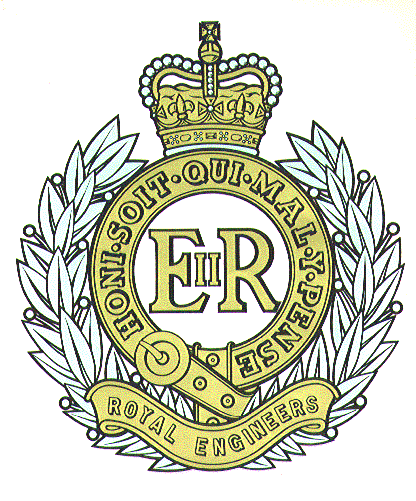
873 Movement Light Squadron, R.E.
Horn Lane, Acton, 1961 - 1993
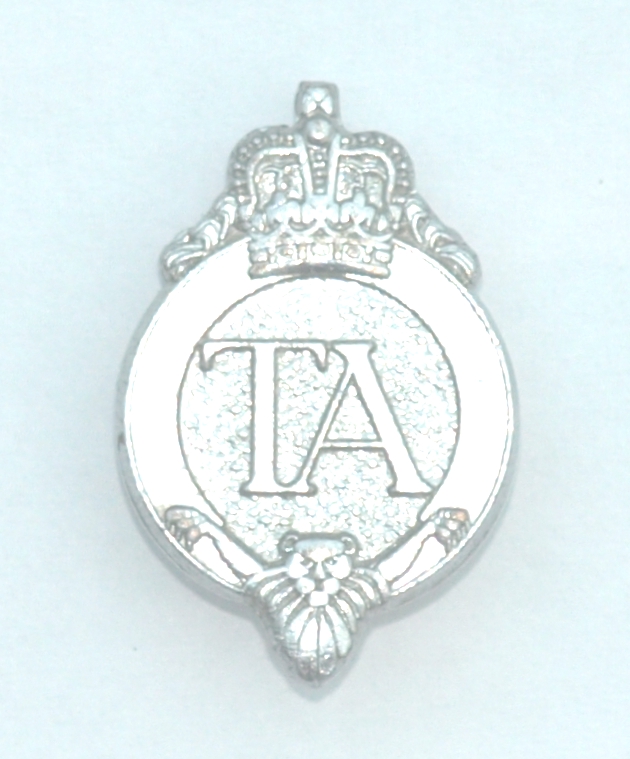
Civil assistance
| WEBSITE POLICY No pop-ups, no adverts. No registration, no log-in. No personal details taken. |
| You may need to 'refresh' this page to see the latest version. |
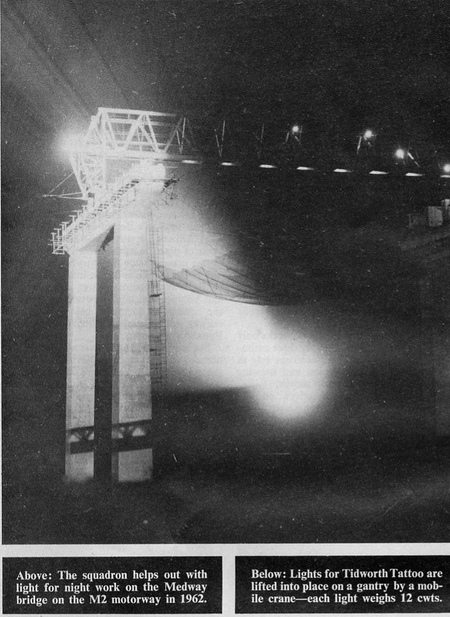
photo courtesy David Samuels
from his Flickr collection
Medway Bridge, 1962
During the building of the M2 Medway Bridge, 873 provided illumination to enable crossing of the Southern Electric railway line on Saturday night/Sunday morning when the current was off.(15)back to top of page
US Army, 1967
In February 1967, 873 assisted the US Army when ammunition was moved to the UK. Following a request, 873 was in postion 200 miles from Acton In 6 hours, with 4 searchlights & a fully-manned command post(15)back to top of page
West Country Floods - Pensford, July 1968
On Wednesday 10th July 1968, over 5 inches of rain fell in the Bristol region in less than 24 hours in the worst storm in over 50 years. Fields already sodden by the wet summer couldn't absorb the rain and some were covered to a depth of several inches causing 'sheet run-off' into the River Chew. During the late evening, a 10-12 feet deep wave swept down the Chew Valley, swamping buildings, and washing away trees, cars and much else.The torrent and the debris hit the Wells Road bridge at Pensford, where the main A37 road passed over a large stone-arched 19th century bridge. The old stonework began to crumble and at about 1am on Thursday 11th, probably after a battering from a fallen tree, it collapsed leaving a 50ft gap, which not only split the village in two, but severed a major holiday route. (Incredibly, the small 15th century 'packhorse' bridge just downstream survived although the parapet walls were demolished.)
With several other bridges in the area also swept away, and in the height of the holiday season, huge traffic jams soon built up on Thursday bringing much of the West Country to a standstill. (This was pre-motorway). It was a civil emergency, and the Army was soon called in.
The following day, Friday 12th, 125 men of 60 Field Squadron Royal Engineers, part of 36th Engineer Regiment, set off from Maidtone in Kent to put a temporary bridge over the river that night. From Swindon, a convoy of 22 army trucks were despatched with sufficient parts for a 110-foot long 'Bailey Bridge' - and from Acton, a small team of part-time sappers from 873 set out with a searchlight to provide night illumination. The journey was made at top speed, to the delight of the driver of the RL, with a police escort all the way, the only stops being when changing police areas. Everything was in place by about 6pm that evening, but it was a difficult site to work in, with a good deal of rubble and debris, sagging power lines, drooping sewer pipes and little room for trucks to unload.
When the light was turned on scores of hands were immediately raised to shield eyes, there was a lot of shouting & swearing, and the light was doused. The officer came over and asked if the light could be dimmed. He was advised no, only by doing what he was previously advised. This time he agreed, and half an hour or so later after the truck and generator were moved, the build proceeded with the help of a nice articial moonlight.
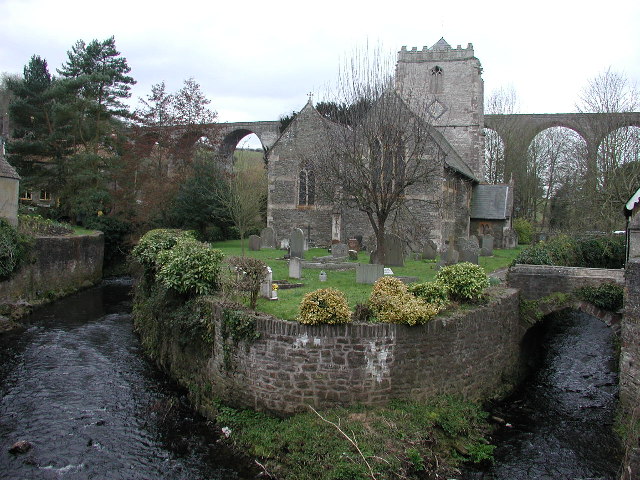 The church tower used to bounce the beam.
The church tower used to bounce the beam.
photo from
| Bailey Bridges are built with extra sections at the front called the 'nose' (later removed) which is raised slightly upwards, as seen here. On the assembly bank there are two sets of rollers; 'launching' rollers near the gap; 'construction' rollers 25ft "inland". The first set also act as a fulcrum - sufficent sections have to remain behind them when the bridge is rolled forward to stop the nose tipping into the gap before it reaches the 'landing' rollers on the other (near) bank. |
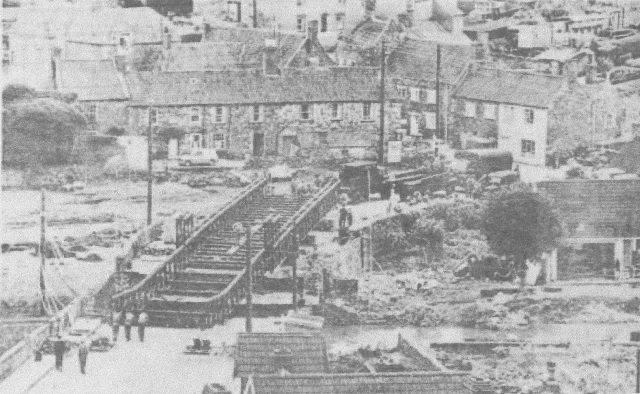
photo from (Bristol?) "Evening Post" Saturday July 13th, 1968
|
On this bridge, the main sections have two side-by-side vertical
panels each side of the bridge, separated by RSJs called transoms; (the nose
has only one panel per side) Once the main section is fully
in the intended position, the rollers are removed and the bridge supported
on base plates. The nose is then removed, and the bridge decking laid. When this photo was taken, the nose hadn't reached the landing rollers, and there's still a lot to do! |
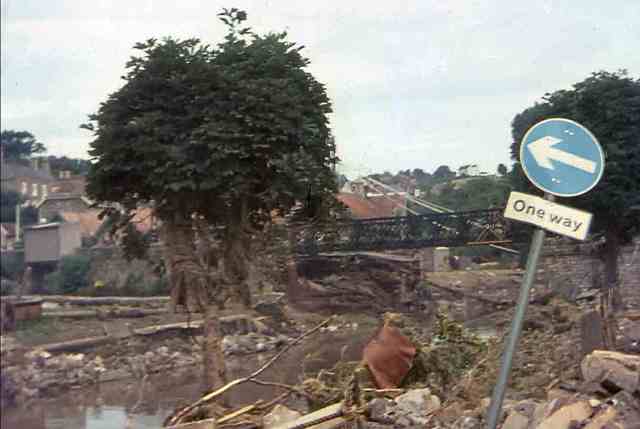
photo:"shippscompass" on Flickr
|
In the photo above centre, the first section of bridge proper has two
panels high. Above photo shows the bridge with just one panel high, the one on the right, after it was opened, seems to show two panels high all along. |
Seven months after its opening, the bridge apparently developed severe buckling, and on 15th February 1969, the weight limit was cut from 30 to 6 tons and a permanent police patrol posted to enforce the weight limit and also the 10 mph speed limit which was being widely ignored. The following week, a party of REs strengthened the bridge.
In March 1969, 8 Field Squadron from Tidworth dismantled the Bailey to make way for the new permanent bridge which was opened on 29th October 1969. During the summer of 1969, whilst the new bridge was being constructed, traffic was diverted through the village and over the narrow 15th century bridge which had survived the flooding.
Peter Cox and Steve West were among the 873 searchlight crew-members.
back to top of page
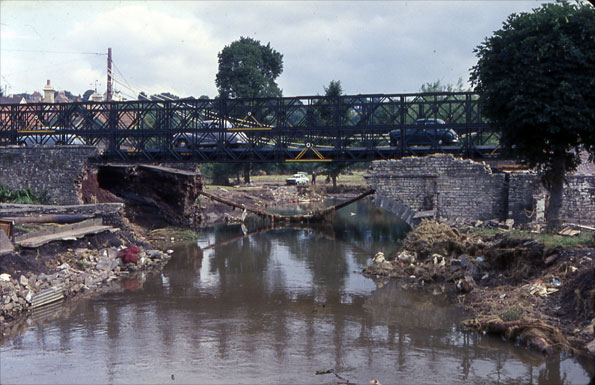
photo from BBC archives
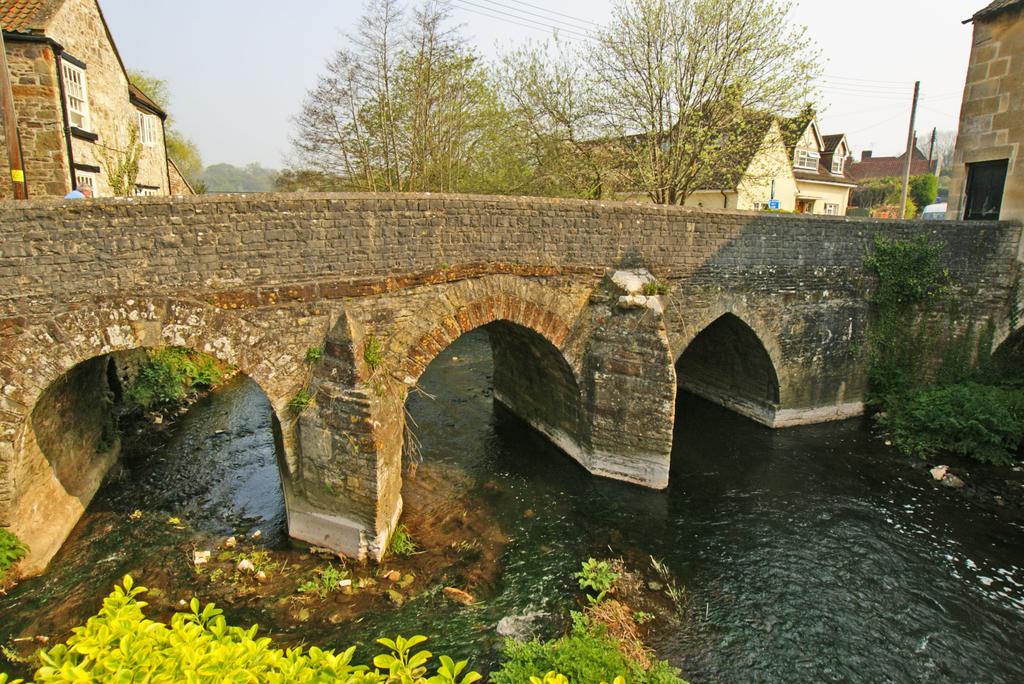
photo from
Molesey Floods, September 1968
back to top of page
Staines air crash, 1972
back to top of page
Webmaster's contact details are at bottom right.
| ACKNOWLEDGEMENTS Main contributors All sources are acknowledged where known. Copyright remains with the original source. |